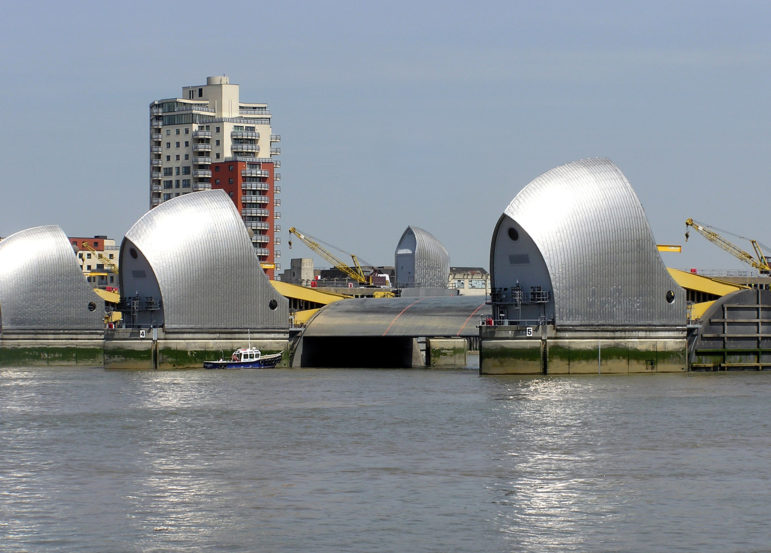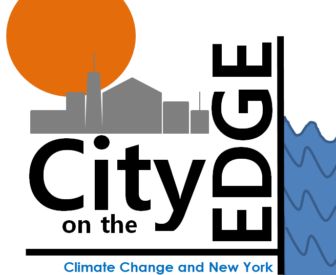
Arpingstone
The Thames Barrier in the United Kingdom. A roughly similar approach could be taken in the New York area, but there are plenty of less ambitious and less costly alternatives.
A menu of possible coastal defense projects to shield New York City from storm surge gets its first public hearing Tuesday night, with a second session—in Brooklyn—on Wednesday evening.
In a process initiated after the devastation of Superstorm Sandy, the U.S. Army Corps of Engineers has identified five strategies for protecting the city from waves and tides that are likely to become more destructive as sea levels rise. The options include a massive sea wall from Sandy Hook, N.J., to Breezy Point in Queens as well as a set of flood barriers and levees across the region.
The Corps has not selected a preferred strategy, but according to the initial cost-benefit assessment included in its interim report last month, some type of large, ocean-blocking structures offer the best bang for the public buck. And there are a lot of bucks at stake: as much as $120 billion for the most aggressive approaches.
The first of eight public hearings on the alternatives is set for Tuesday from 5-7 p.m. at the Westchester County Center at 198 Central Avenue in White Plains.
The de Blasio administration has kept mum on which strategy it wants to pursue. “We support the U.S. Army Corps of Engineers conducting a full study and analysis of all alternatives,” says Phil Ortiz, a spokesman for the Mayor’s Office of Recovery and Resiliency. “The city looks forward to continuing to participate as a Non-Federal Project Partner and will continue to work directly with the Corps to arrive at the best outcome to protect New York City and surrounding communities.”
The city and state invited the Corps to do the study, and their approval would be necessary to proceed toward final approval, which would be unlikely until 2022. All three levels of government would likely share in the costs of the project.
The question of how to protect New York City arose in the immediate aftermath of Sandy, when the Bloomberg administration crafted the Special Initiative for Rebuilding and Resiliency or SIRR, which identified a set of projects around the city to improve resiliency. Seth Pinsky, who led that effort, said a harbor-wide wall was explored and rejected.
“In a world of unlimited resources, a large-scale surge protection barrier of the type the Army Corps and others are discussing would probably make sense. We are already at risk from storm surge, as Hurricane Sandy illustrated, and the risks are only going to grow,” Pinsky told City Limits. “The concern that we in the Bloomberg administration always had with this particular approach, though, was that a project such as this would likely soak up all or a huge portion of the resources available to protect against climate change, while addressing only a subset of the impacts that this change is going to have.”
Get the best of City Limits news in your inbox.
Select any of our free weekly newsletters and stay informed on the latest policy-focused, independent news.
He continued: “It does nothing about the day-to-day impacts of sea-level rise, about excessive heat, about heavy rainfall. So it has the potential to leave us vulnerable to a wide array of risks.”
Doubts about massive tidal barriers are held widely. “We’re investing heavily in a new climate adaptation economy,” says Annel Hernandez, associate director of the New York City Environmental Justice Alliance. “We have to make sure the infrastructure is providing other crucial benefits for communities, not just a wall out in the bay that is only activated during the actual emergency event. We would want infrastructure that would be useful and accessible on a sunny day,” like waterfront parks that absorb water and provide recreation.
“The problem with a sea wall is, it would have a lot of impacts on the health of the waterways which would in turn would have an impact on the ability for ecologically grounded coastal protections,” Hernandez added. Sea walls, for instance, can change how tides and sediments move, which can affect the health of wetlands that resist storm surge.
While there are doubts about the Corps’ plans, Hernandez says the agency has made progress when it comes to outreach. “The first step in the right direction was definitely in the fact that they’re having a much more robust public engagement process and that they’re making sure to give notice and expand the number of stakeholders across the city that they are reaching out to.”
Beyond Tuesday night, seven more meetings have been scheduled:
Wednesday, March 13th, 5:30-7:30 p.m. South Shore Educational Complex (Auditorium), 6565 Flatlands Avenue, Brooklyn, N.Y.
Tuesday, March 19th, 5-7 p.m. Snug Harbor Cultural Center, 1000 Richmond Terrace, Staten Island, N.Y.
Wednesday, March 27th, 5-7 p.m. Middletown Arts Center, 36 Church St., Middletown, N.J.
Wednesday, April 3rd, 5-7 p.m. at the Hudson Valley Community Center, 110 Grand Avenue, Poughkeepsie, N.Y.
Tuesday, April 9th, 5-7 p.m. Location: Alexander Hamilton U.S. Custom House, 1 Bowling Green, New York, N.Y.
Thursday, April 11th, 5-7 p.m. at the Meadowlands Environment Center’s first-floor auditorium, 2 DeKorte Park Plaza, Lyndhurst, N.J.
Wednesday, April 17th, 5-7 p.m. at the Hostos Community College, D Building/Savoy Manor Building, 120 East 149th St, 2nd Floor, Bronx, N.Y.










3 thoughts on “Does New York City Need a Sea Wall? Your Chance to Weigh In Has Arrived”
So to heck with the people as long as the wall does not interfere with the wetlands!!!! I have lived in my house in Hamilton Beach since 1959. There was no flood insurance at at that time. Then there was flood insurance which was about $600.00 a year. So now I am 86 and have to pay over $3000.00 a year for flood insurance and I am on social security. These walls should have been built back in 1965 according to papers we read but the money never came through. How come???? This could have been done 50 years ago and probably would have been a whole lot cheaper.
I think the concern for wetlands is precisely that they help to protect people by buffering storm surge, do so in a way that strengthens the ecosystem on which fishing depends, won’t take a quarter-century to build, and don’t cost so many tens of billions of dollars that they protect coastal residents at the expense of other NYC-area residents who are primarily vulnerable to other aspects of climate change, like riverine and surface flooding, heat emergencies, et cetera.
Pingback: Can New York Protect Itself from Rising Seas by Just Getting Bigger? - Naija Leads